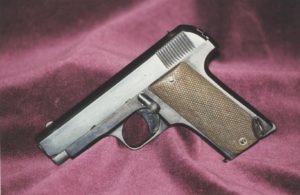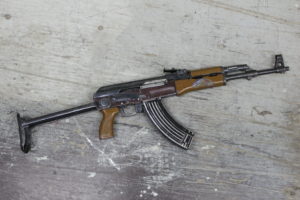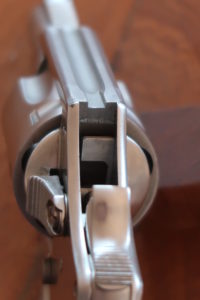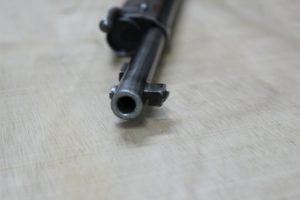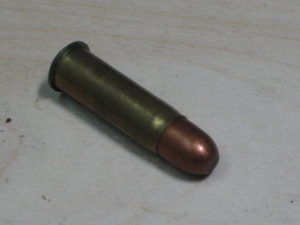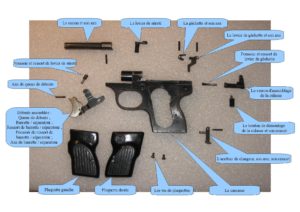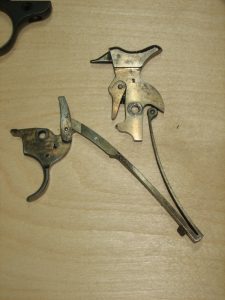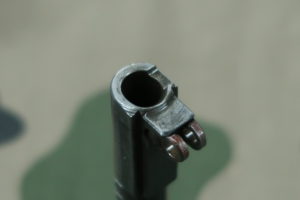While in modern times wars are more and more devastating in human life, it is particularly interesting to dive back into the ancient writings to see how things unfolded at a given period and thus see the evolution of uses. military or industrial … among others. For the first article in this series on the Chassepot rifle, we will immerse ourselves around the year 1869 and study the score of a book of this time. A second article, to appear later, will give us figures concerning the Chassepot 1866 rifle. We will see in the conclusion of these articles, if one can draw lessons from the elements put in relation.
The Chassepot 1866 rifle
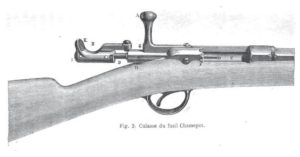
We will use to present this weapon, the score of a book in which I took care to put in bold the passages that appear significant to me. This book is called: The Wonders of Science: or Popular Description of Modern Inventions by Louis Figier (Volume 3 – 1869).
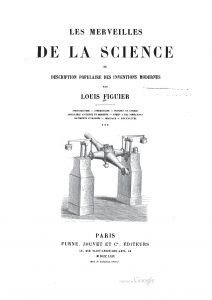 Transcript of the book :
Transcript of the book :
The Chassepot rifle – its effects – transformation of our old rifles.
The bohemian campaign and the victories of Prussia on the battlefield of Sadova, in 1866, showed, with overwhelming evidence, the merits of the Prussian rifle. In the aftermath of these events, and in the presence of these results, the nations of Europe, which had given up, without much attention, the needle-gun, had to return from their indifference, and adopt the new weapon. In France, as elsewhere, it has been quick to replace the old piston guns with the needle rifle. Only the Prussian rifle was liable to various reproaches. A commission formed at the Ministry of War, studied, in 1866, the modifications that might be made to this system, and from his studies came the adoption of an irreproachable model of needle-gun, proposed by Mr. Chassepot.

It is this rifle, officially designated under the heading of weapon 1866, that we will describe. The foregoing details, which contain the exposition of the principles of the construction of the Prussian rifle, will allow us to greatly abbreviate the description of the new French army.
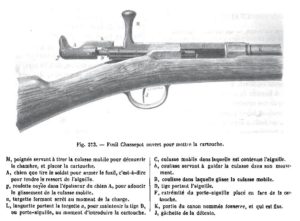
The pieces composing the Chassepot rifle are simpler and less delicate than those of the Prussian rifle. The dog is of sufficient size. It offers a large catch, as a result of the roughness of the surface that ends it. In addition, so that in the arming of the dog, this piece does not come to be forced by the pressure exerted, it was provided with a roulette, to facilitate the sliding. By pulling the dog, which holds a portion of the sheath, containing the spring of the needle, the rifle is armed.
To open the chamber, the breech is pulled by means of the handle; the cartridge is placed in the cavity which must receive it, in front of a steel disk of a radius less than that of the chamber. Below this disc is a small rubber cylinder, filling exactly the diameter of the chamber. This cylinder is more galvanized on the edges than in the middle, so that, under the influence of the pressure of the gases, the central part of the rubber gives way and prevents the exit of the vapors by the joints of the bolt with the barrel . The decline is mediocre.
To close the weapon, push the handle back to its first place and then fold it to the side. The first of these moves the cartridge into the barrel; the second immobilizes the cylinder head by placing a projecting portion of the handle in a notch. By pulling the trigger, the trigger unleashes the spring of the needle that strikes the fulminant capsule, and the dog is brought back, after the shot, to its first position.
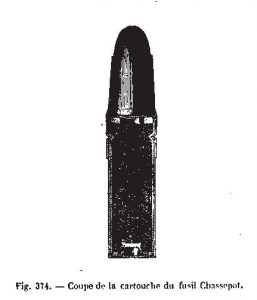
The cartridges are of thin paper, and consolidated by a silk gauze envelope; it thus presents the two essential qualities of any good cartridge, namely lightness and solidity. An invaluable advantage is that it is completely burned by the burning of the powder. The capsule is attached to the lower base of the cartridge, the opening facing the needle. In this it differs from the cartridge of the Prussian rifle, in which the needle must pass through all the powder, to strike the fulminant capsule. We have explained at some length the advantages which are found in producing inflammation from the top of the cartridge, and not from the bottom, as in the ordinary case. But this provision required the use of a needle twice as long and therefore more fragile. This is what decided, in France, to give up placing the capsule at the top of the cartridge. The theoretical advantages which we have enumerated above concerning this mode of inflammation, not being able, as it seems, counterbalance the disadvantage of the too great length of the needle. When the needle comes to shock the fulminate, the flame is communicated to the powder by two small holes drilled in the bottom of the cell.
The French cartridge is expensive, and its manufacture requires minute precautions; but it works beautifully.
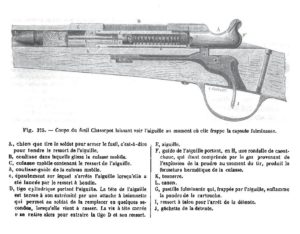
After these preliminary explanations, we will better understand the two figures that represent the mechanism of the Chassepot rifle, with the legends that explain the use of its various organs. Figure 373 shows the open shotgun for loading; Figure 375 represents the weapon of the moment when the needle strikes the fulminant capsule.
The Chassepot rifle is far superior to the Dreyse rifle, it does not present the complication of the Prussian weapon; these movements are fewer; loading is fast and easy. The needle being withdrawn in its sheath during the loading, and being able to leave it only at the moment of the shot, any explosion of the cartridge, during the load, is made impossible. No more gas loss or fouling, which did little to reduce the speed of fire.
The Chassepot rifle is shorter than our old ammunition rifle; it weighs only 3 kilograms, and carries a bayonet sword lighter than the old one. The form is elegant and satisfies the self-esteem of our soldiers. The barrel, whose caliber is 11 mm, bears 4 helical stripes. Thanks to the absence of any loss of gas, these scratches retain their full effect, and make the weapon a real rifle.
Marshal Niel sent the Emperor a very interesting report on the results of the firing tests with the new rifle. According to this report, the Chassepot rifle can fire, without aim, 14 shots per minute, and aiming, 10 shots per minute. It is 1000 meters, more surely than the old rifle bore 400 meters. At this huge distance, a somewhat experienced soldier puts 24 balls out of 100 into a target. An army of 20,000 men, equipped with this destructive machine, could fire, per minute, 280,000 hits and lay 56,000 enemies on the ground, if the battlefield fire was as accurate as the target shot.
With this prodigious weapon, victory and defeat can be decided in a few minutes. About twenty lights will end a battle. It will be a quarter of a league away, without almost seeing each other. Before we can get near, the new rifles will have done their work of extermination: the enemy, terrified and decimated, will be put to flight. Thus, the barrel itself is exceeded, and the soldiers, it can be said, have lightning in hand.
Marshal Niel’s report, on which these astonishing conclusions are based, is of great importance in the question before us. We therefore feel obliged to put most of this document before the eyes of our readers. In these kinds of questions, the figures, the precise results, alone form the opinion; it is therefore on the numbers that we must insist.
Marshal Niel’s report to the Emperor is intended to summarize all the results obtained since the transformation of our armaments has become a fait accompli. After a few words of introduction, the author of the report expresses himself in these terms:
“Begun in September 1866, but as a test, by the battalion of foot-hunters of the Imperial Guard who had been appointed to carry out the first experiments, the delivery of the new rifle in the corps of the guard did not really date only from the end of March 1867. “
“Successively extended to the various infantry corps of the line, as and when the progress of manufacture, this considerable operation ended in April 1868, ie in a period of time A few recent years, especially for many infantry corps of the line, the time of the commissioning of the new rifle, the tests already made allow to sit, dice to present, the opinion on its real value as a weapon of war. “
“Its effective regulatory range is 1000 meters and can easily reach 1100 meters.” The projectile, with an initial speed of 410 meters per second, runs a fairly tense trajectory so that at a distance of 230 meters it does not rise more than 0.5 meters above the line of sight, this tension being one of the most favorable conditions for effective shooting. “
“As a result of the simplicity and promptness of the loading that man can perform with the same facility in all positions, kneeling, sitting, lying, as well as standing, the soldiers manage to shoot 7, 8 and even 10 shots per minute aiming, and up to 14 shots without aiming. “
“It is worth recalling here that for the old infantry rifle the maximum effective range never exceeded 600 meters with an initial speed of 234 meters per second only, and it is barely under normal conditions of regular fire the well-trained soldier could fire more than two rounds per minute, with a weapon whose loading by the mouth could only be executed in the standing position, forcing him to discover himself in all circumstances. “
“Thus: considerable increase, almost double of the old one, in the range of the shot, increase of the third in the speed of the projectile, much greater tension of the trajectory; such are, joined to a speed of firing unknown hitherto, the essential qualities first revealed by the practice of the 1866 rifle. “
“From the point of view of accuracy, its benefits are no less satisfying, and I have had the record of target shooting sessions in the different corps carefully taken since they were in possession of the new rifle.”
“The armament could not be distributed at the same time in all corps of the army, this part of the instruction, whose degree of advancement is necessarily proportional to the time elapsed since the commissioning of the In the beginning, the first results reported are already very much superior to those obtained with the old rifle. which the men knew well and which they had learned to practice in a long time.Where the results obtained by the regiments of the guard, and especially by the foot-fighter battalion, that of all the corps which, by the priority of the armament, had the most time to employ in these exercises, they testify by their rapid progress of the facility with which the men become acquainted with their weapon as well as its precision. the average number of bullets, out of 100, put into the target at different distances, first with the old rifle, then with the new one, for each of the categories of troops corresponding to the successive epochs of the armament, presents, under this report, comparisons of the highest interest, of which I ask your majesty the permission the detail before his eyes. “
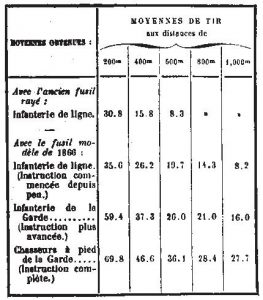
“Today, if we take the general average obtained with the model 1866 rifle, it is easy to appreciate how much this weapon carries it in precision on the old rifle striped, at ordinary distances of 200, 400 and 600 meters. “
“At great distances, at 1000 meters, the useful results exceed the average of the effect produced by the latter at 400 meters, and reach twice that obtained previously at 600 meters, extreme limit of the effective range of the then shot.”
“These results themselves are not yet the definitive expression of the value of the new shot.When recently armed corps have had time to complete their exercises, there is no doubt that the average infantry corps firing of the line will rise rapidly, as for those of the guard, in large proportions.Many disadvantages arising from various causes, inherent for the most part to defects of detail in the manufacture, and to which it was promptly brought remedy, are manifested during the tests and at the beginning of the commissioning in the bodies. “
“These inconveniences, very exaggerated at their origin, and in all cases, made more sensible by the lack of custom in our soldiers, in the handling of a brand new weapon for them, consist of breakage of needles and moving heads, spitting, splits of wood, misfires of bullet cartridges and especially blanks. “
“None of these accidents are of a serious gravity today, and men, in familiarizing themselves with their rifles, learn easily, and in a very short time, to avoid themselves any inconvenience in newly armed bodies. “
“The breakage of needles and moving heads, quite numerous during the trial period, was due to faulty temper and insufficient annealing, which has been remedied by modifying the manufacture accordingly, and the average of the needles. in the bodies is now very weak, it is inferior to that of broken chimneys in the old percussion rifles, and many of these accidents must be attributed much more to the clumsiness of some men than to a defect in the mechanism of the weapon. “
“Replacing a broken needle with fire is, moreover, an extremely simple operation, in which soldiers are trained and perform on the spot with the utmost speed.”
“The spitting, caused by a defect in the manufacture of the weapon, is extremely rare, it is remedied by changing the breech box or the cylinder of the breech.The same accident can be caused by defective washers; is easier than changing these washers. “
“Finally, under the influence of the lowering of the temperature, gas leaks have sometimes been observed, but only by quite considerable colds which remove the shutter its efficiency.” Experience has shown that in this case , the spitting almost always disappears after the first shot, the shutter resuming its normal shape under the action of the heat developed by the ignition of the charge.These coughing, moreover, may be likely to annoy the shooter, do not seem likely to hurt him. “
“Some woods have split due to a defective wood setting, this defect is currently avoided in the manufacture.With a slight repair, the split woods do not cease to be likely to good service in the body.”
“The first cartridges that were used were of a slightly weak size, under the impact of the needle they slid forward, hence misfires, the number of which appeared at first quite high. with the blank cartridges which were not stopped by the projectile as a bullet cartridge, which was remedied by lengthening the cartridges with bullets and without bullets, and increasing the diameter of the cartridge without a bullet. “
“The weak coil springs also produce misfires that are avoided by using stronger springs, and the change is made with the utmost ease.”
“Despite some imperfections of detail, inevitable in the beginnings of any new system, all of our armament is excellent, and all bodies have welcomed it with the greatest sense of satisfaction.”
“The new rifle, lighter than the old, graceful in form, pleases the soldier, full of confidence in his weapon, he loves it, surrounds it with particular care, a very striking mark of predilection which proves once more how much more, with their intelligent insight, our soldiers spontaneously grasp and appreciate what is really good and useful. “
“The 1866 model rifle is easy to handle, its mechanism is simple and convenient, its easy maintenance, it requires only a very short instruction to become familiar to men, who assemble and dismount it without difficulty, and learn to quickly replace the moving parts they are equipped with, such as washers, needle, movable head and coil spring, and in a very short time the less skilled soldier can be introduced to the operation of the whole system. “
“The experiments done with the greatest care, last year, at the camp of Châlons, then in Italy by the troops of the expeditionary corps, under the most diverse and often the least favorable climacteric circumstances, furnished the proof that, under a rather delicate appearance, the new rifle fulfilled the best conditions to satisfy all the necessities of the campaign service. “
“Studied from all points of view, the rifle which the French infantry has just endowed meets in the highest degree, with an accuracy and speed of fire incomparable qualities that should ensure him the first rank among the weapons of war today in use. “
End quote from Marshal Niel’s report.
While pushing with great activity the manufacture of Chassepot rifles, the French government was thinking of using the old ammunition rifles which filled our arsenals. Since the conversion of these old rifles into a Chassepot rifle was impossible because of the excessive expenditure which it would have required, one sought, among the various known systems of arms loaded by the breech, the one which would lend the most economically to a transformation into a rifle loading by the breech. The choice was based on a combination of two systems of English origin, the Enfield and Snider rifles. “
End of transcription.
This article asks for further developments and deepenings, they will be done in a future article.

